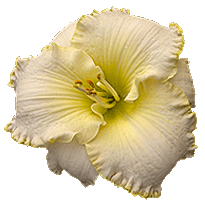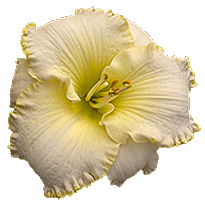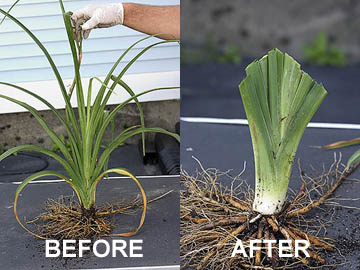




Sadly, here in USDA Zone 5, by early September the daylily bloom season is winding down, with only the late season bloomers and those daylilies that re-bloom still holding forth their colors as the length of the days gradually wanes. It will soon be time to think about preparing your garden beds for the winter. Meanwhile, if there's a bare patch in your garden that craves to be filled, or if you want to stop dealing with those annuals that have to be replaced every year, it's still not too late in the season to plant or divide and transplant daylilies. This is the time that we, in fact, are in the midst of dividing clumps and "lining out" the individual daylily fans, a process that will continue for the next few weeks. It's not too late for daylilies to settle in and establish their roots before the onset of winter; they'll be in place and ready to flourish come spring.
When we dig and divide the clumps, we also shear back the leaves as shown in the accompanying pictures. Don't be fearful of the process; the plants will bounce back much quicker if trimmed as shown, rather than being left untrimmed. The leaves can be cut back to a length of about six to eight inches. Although not shown in the pictures, we also shear back the roots to about six inches in length.

For any daylilies that are transplanted at any time of the year and especially for those that have been newly divided, we recommend daily watering for a week or so afterwards. Speaking of watering: It’s generally known that daylilies love water (but not wet feet), and many gardeners are diligent about watering their daylilies up to and throughout the bloom season. It is just as important to see to it that your daylilies continue to receive adequate water after the bloom season is over and right up to the onset of winter. Continuing to water them during this period will help condition them to get through the winter.
This time of the year also brings thoughts about the winter hardiness of our daylilies. Daylilies as a group are known for their hardiness to several factors such as drought, heat, and cold; but individual cultivars vary considerably with regard to these stressors. The actual degree of winter hardiness varies with the specific cultivar, the climatic zone in general, the specific local weather conditions of that particular year, as well as how well the daylily has been nurtured in the garden with good soil conditions, fertilizer, and regular watering. All else being equal, a well maintained daylily will survive the winter far better than a poorly maintained one.
You may have heard snow referred to as "poor man's manure"; it might also be called "poor man's mulch" because if a good snow cover were consistent throughout the winter it would protect your daylilies and other perennials from bitter cold and wind -- a blanket of insulation against the elements. But since we cannot rely upon nature to provide snow shelter for our daylilies, we recommend mulching them, particularly those daylilies whose hardiness is uncertain as well as those that have been transplanted late in the season. A few inches of mulch will not only protect daylilies from "open" (i.e. lack of snow cover) winter weather, but also from the threat of frost heaves during the freeze-thaw cycles of early spring. Frost heaves, in fact, can actually be worse for your daylilies than the bitter cold of winter because they can lift the daylily enough to expose its crown to the elements resulting in severe damage or loss.
A number of materials can be used as winter mulch such as leaves, pine needles, straw, or bark mulch. At Daylily Meadows we prefer to use aged (rotted) hemlock, year round, because in addition to providing winter protection, its advanced state of decay causes beneficial nutrients to be released into the soil.
Next Article - Daylily Proliferations
Back to - Daylily Article Index
For Reference - Glossary of Daylily Terms

| Home Page | Our Daylilies | Slides and Videos | Daylily Cultivation Article Index |
| Information Center | Site Map | Offsite Links |
Internet Explorer 5+
Mozilla Firefox 2+
(You can download either of the browsers listed above by clicking on their name link)







